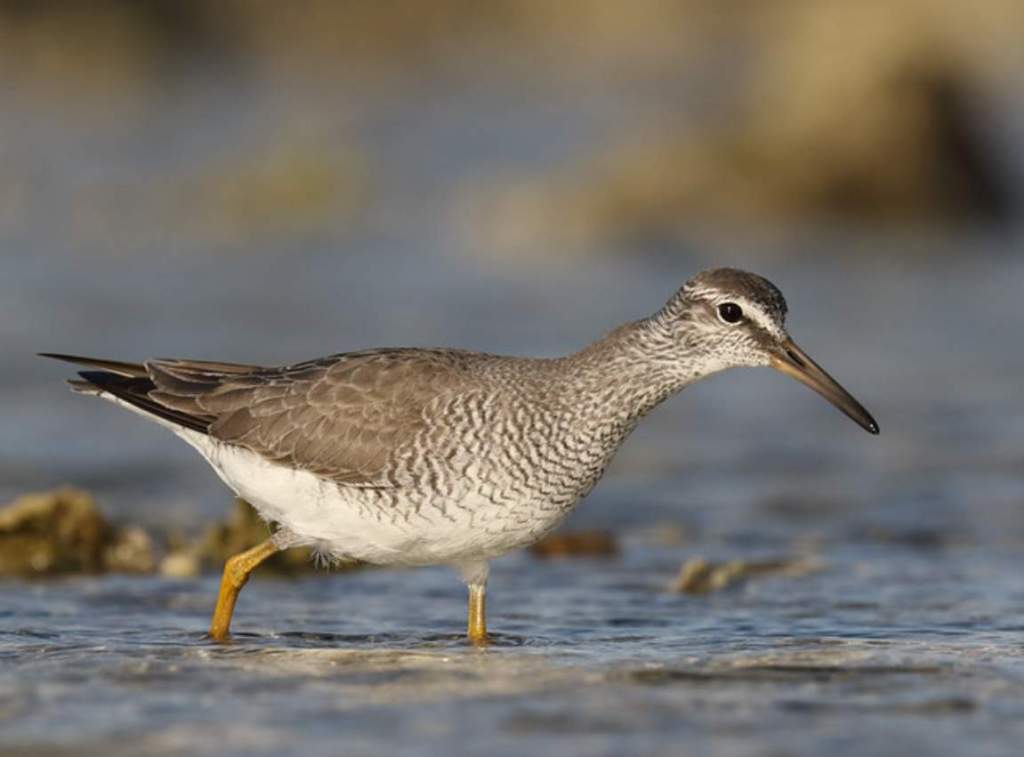Range: One of the most common waders visiting Australia, the Grey-tailed Tattler (Tringa brevipes, previously Heteroscelus brevipes) can be found in considerable numbers around the north. The species becomes less common further south, appearing only sporadically in Tasmania and South Australia. In Victoria, it occurs occasionally on Mud Island and in Western Port Bay. There are two populations of Grey-tailed Tattlers in the world: one breeds in coastal Australia and the other lives in Southeast Asia and New Zealand. Eastern Siberia and Kamchatka are its breeding grounds.

Behaviour: Mid-August marks the start of the birds’ departure from their breeding grounds, in northeastern Siberia; they arrive in Australia during September and leave again through April. Due to the fact that some birds – mainly young ones – stay in Australia throughout the year, the exact date of their arrival and departure is unclear. In contrast to flying over land, they appear to travel over a broad front, traveling from the northwest coast to Cape York, and then spreading southward. Instead of arriving from the east coast, some may reach the South Australian gulfs from the southwest.
Grey-tailed Tattlers are found on mud flats at the mouths of estuaries and adjacent rock piles, reefs, and muddy mangrove-lined inlets in Australia, either alone or in flocks of up to 50 birds, or mixed with other waders. Sand beaches are rarely visited, and are usually only used for roosting. As often as not, the birds rest on bare branches of mangroves or on rock platforms during high tide. On landing, they usually stretch their wings vertically before folding them before flying off low with clipped wingbeats.
Feed: As they wander around, bobbing their heads and wagging their tails, they probe in the mud for food, such as crustaceans and other invertebrates found in the intertidal zone.
Alternative Names: It is also known as the Grey-rumped Tattler, Grey-rumped Sandpiper, and Siberian Tattler.
Size: The size is approximately 260 to 270 mm in length.

Identification: As far as Grey-tailed Tattler identification is concerned, both sexes are similar. Plain light grey above; below with white eyebrows and dusky lores. Eyes are brown. Bill is black. Legs and feel yellow-olive. Non-breeding plumage looks identical to Wandering Tattler, but the bird is smaller, has a shorter nasal groove in the bill, larger leg scales, and a slightly different two-note call. In breeding plumage, the underparts are barred with dark brown, except for the white center of the belly and white undertail coverts. The immature birds are like adults in nonbreeding plumage but with pale edges to feathers on the back and upper surfaces of the wings.
Call: Their displays and calling resemble those of the Greenshank; like that species, they often perch in dead branches. The call is fluty to a strident troo-eet, troo-eet, troo-eet in alarm.
Nesting & Breeding: Moreover, the nesting and breeding occur between June and July in Siberia. Both males and females share incubation and care for their young. Their breeding grounds are in the most remote and mountainous parts of Siberia, and it was not until 1959 that the first nest with eggs was found. Birds arrive to nest from mid-May to early June and begin courting from the first day.
Eggs: Grey-tailed Tattler lays four eggs, pale buff with dark blotches, mainly at the larger end; oval to pyriform, size not yet reported.
Races: There are no races.
Similar species: Grey-tailed tattlers are closely related to their North American counterparts, wandering tattlers (T. incana). Red shanks are similar in size and shape to these birds.
Family: It belongs to the family Scolopacidae
Read More – The Versatile Little Ringed Plovers







